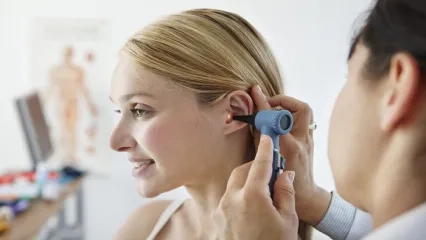Alo Yeditepe
Alo Yeditepe
Adenoid and Tonsil Problems in Children
Yeditepe University Kozyatağı Hospital Ear, Nose, and Throat Specialist Prof. Dr. Müzeyyen Doğan answered the questions about adenoids and tonsil problems in children.
What is an Adenoid?
Adenoid is part of our immune system. It is in the nasal region behind the nasal cavity. Also known as adenoid tissue. It is structurally composed of the cells that make up the tonsil tissue but has no capsule. Adenoid is especially prominent in the first years of life.
Why Does Adenoid Grow in Some Children?
Upper respiratory tract infections and allergies are the leading factors causing the growth of adenoids. Genetic factors are also known to be effective in adenoid growth. However, in cases where gastric fluid reaches the mouth, growth may also occur in the adenoid tissue. Research shows that allergies and reflux are also risk factors for adenoid growth. One study showed that the risk of adenoid growth increased 9.6 times in children with pathological throat reflux and 5.4 times in children with pathological stomach reflux. Because of all these, especially during periods when allergies are intense, the adenoid also grows more.
At What Age Does Adenoid Affect Children? Does It Normally Disappear with Age?
Adenoid grows in the first years of life, between the ages of 2 and 8 when children first encounter environmental factors such as germs and allergens. However, it begins to get smaller in the following years due to the development of the immune system in children. In parallel with the infections in the upper respiratory tract, which we frequently see in children, there is an increase in adenoid problems, especially in the winter.
What Kind of Issues May an Adrenal Growth Lead To? What Symptoms Which Symptoms Suggest an Adenoid Problem?
Adenoids produce antibody cells to protect the body against microbes that reach the upper respiratory tract. However, for the adenoid to cause problems, its dimensions need to reach a level that will reduce air passage through the nose and/or close the mouth of the eustachian tubes that ventilate the ear. When the problem reaches this point, breathing difficulties through the nose, continuous breathing through the mouth, developmental disorders in the teeth and jaw, urinary incontinence, growth, and developmental retardation can be seen. Problems such as restlessness, nasal talking, ventilation disorder in the middle ear and consequent collapse of the ear, frequent recurrent otitis media, wheezing, snoring, sinusitis, coughing, nasal discharge, headache, and depression may occur.
How Is Adenoid Diagnosed?
If the child has symptoms that suggest adenoid growth, it can be diagnosed by looking at the adenoid area with a small camera through the nose. If the child has problems adapting to this examination, a direct radiograph showing the airway can be taken. In this film, we can see how much the adenoids have blocked the airway.
Are Imaging Methods such as CT, and MRI Needed?
CT is not our preferred imaging method in children. If the appearance of the adenoid and the general condition of the patient during the examination suggest another mass, then an MRI may be performed. It is not used as a routine diagnostic method.
Is It Treatable with Drugs?
If allergy is at the forefront as the reason for the growth of the adenoid, it is possible to shrink it with allergy drugs. In addition to allergy drugs, it is also useful to clean the nose with seawater sprays.
In What Situations Is Surgery Required?
The following conditions are among the main indications for surgery:
- Nasal congestion
- Retaining breath while sleeping
- Frequent recurrent inflammation of the adenoids
- Frequently recurring otitis
- Speech disorder
- Disturbance in tooth and jaw structure
- Growth and development retardation
Sleep quality may be impaired due to adenoid growth. Since this reduces the release of sleep growth hormone, growth improvements in children may be adversely affected. Again, the jaw and tooth structure may change in children who breathe through the mouth, not through the nose, due to adenoids, and tooth decay is more common in these children.
What is Performed in Adenoid Surgery?
The operation of adenoids is performed under general anesthesia. A syrup is given to relieve the patient before they are discharged from the operating room. Then, they are asked to blow into the anesthesia balloon with the help of a mask in the operation room. While blowing into the anesthesia balloon, the patient begins to sleep, and the other steps of the general anesthesia are completed. The mouth is opened by applying a tool called a mouth opener. There are 2 methods. The first is the method of obtaining adenoid with the help of a curette. The other is the evaporation method. Today, the evaporation method (plasma method) is widely used. After the application area is given physiologically, the area with excessive radiofrequency energy in the adenoid evaporates with the effect of plasma and is vacuumed away with the help of a specially designed device.
Is Adenoid Surgery Difficult, How Long Does It Take? Which Anesthesia Method is Used? Are There Risks?
Adenoid surgery is performed under general anesthesia. Especially in the evaporation method, the time is about 10-15 minutes. With the help of the camera, the nasal area is seen, and it provides the opportunity to do so without damaging the surrounding tissues. This also minimizes the risks. On the sides of the adenoid region are the mouths of the eustachian tube, which vents the ear. These structures may be damaged in the process of removing excess adenoids without seeing them. However, since there is a sufficient viewing angle with the camera in the Coblator system, there is little to no risk.
What is the Process After Adenoid Surgery? Is Hospitalization Necessary?
Nutrition is started 2 hours after the operation when the sleep-inducing effect of general anesthesia is eliminated. It does not have a special diet as in tonsil surgeries. If there is little to no possibility of complications with the evaporation method, they are discharged on the same day.
Will There Be Pain Post-Op?
No nerve tissue perceives pain sensation in the nasal area. This is why it is a painless operation.
How Long Does It Take for Problems Associated with Adenoid to Disappear After Adenoid Surgery?
Complaints of nasal congestion begin to improve from the first day in some patients. The passage of the obstruction in the nasal area leads to an increase in the level of growth hormone in the blood. One study showed a significant increase in growth hormone levels 6 months after surgery. Since the mouth of the eustachian tube, which ventilates the ears, is opened, the frequency of otitis media begins to decrease. The decrease in the frequency of infection after the operation, the increase in growth hormone, and the increase in sleep quality are positively reflected in the growth and development of the child. Problems such as restlessness and sleep disorders were also reported to decrease.
What Should Parents Pay Attention to After Adenoid Surgery?
We prefer to use seawater or saline sprays when cleaning the nasal secretions after surgery. Care should be taken that the sprays used are not high-pressure. High-pressure sprays may irritate the operated nasal area in the early period and cause bleeding. In addition, if they are an allergic child, they should be reminded that their allergic drugs should not be discontinued after the surgery.
What Do Tonsils Do?
Tonsils form part of our immune system. It is located on the right and left sides of the tongue root. It is a collection of lymphoid cells surrounded by a capsule. Everyone has it at birth. As they encounter microbes, the cells in the tonsils form lymphocytes and antibodies. Thus, the body learns to protect itself against microorganisms that it encounters for the first time and can harm.
What are the Causes of Tonsillitis in Children?
Usually, bacteria and viruses lead to tonsillitis. The effect of bacteria in childhood was reported as -30. The most detected bacteria are group A beta-hemolytic streptococci.
Are the Symptoms of Tonsillitis Different from Viruses and Bacteria?
In both, the patient's complaint is sore throat and weakness. In the beta microbe, white-colored tissues are formed on the tonsils. We can also see this image in infectious mono and adenovirus infections. However, lymphocyte counts in the blood count and the image of blood cells in the peripheral smear help us make a differential diagnosis. With the rapid strep A test, we can find out whether there is a beta germ in the throat within 15 minutes. In the meantime, if there are people who have a throat infection in the same house or the immediate vicinity of the patient, it is useful to know the causative microorganism for diagnosis.
Why do Some Children Have Frequent Tonsil Infections?
Children often get sick during play and school-age periods when they are just starting to encounter microbes. Their body recognizes the microbes in every disease, and in the next encounter, it is milder or does not get sick because it shapes the defense system according to the microbe in question. People's immune systems, like other organs in their bodies, have genetic differences from person to person. Some people's immune systems are not as strong, and they can get the same infection over and over again at the same severity. Another factor is the deterioration of the tissue in the throat due to allergies or reflux, and germs can easily cause infection by crossing the protection barriers here. In addition, the presence of an individual with group A beta-hemolytic streptococcus in the family may not cause symptoms in adults but often leads to chronic tonsillitis in children.
Do Iced Beverages or Ice Cream Cause Tonsil Infection?
Tonsil infection is caused by germs. Eating or drinking cold foods or beverages may cause sore throat in people with chronic pharyngitis. Sensitivity of the tissue at the back of the throat.
How to Treat Tonsil Infections in Children?
For the treatment of tonsil infection in children, we need to know about the possible causative agent. Here, quick antigen tests and blood count results help us. A throat culture should also be performed if the patient has a history of recurrent throat infection and/or a patient with a beta virus in the vicinity. Especially in young children, antipyretics are given to control fever if it is high. The causative virus, on the other hand, includes recommendations for symptoms such as using drugs to decrease the patient's fever and pain and having them rest. If the active substance is beta, antibiotics are started, and antibiotic treatment is continued for 3 more days after the fever decreases. The throat culture is repeated 3 days after the antibiotic treatment is completed. It is particularly important to remove this microbe from the body, especially in childhood. In some patients, the beta microbe, which can settle in the heart valves and kidneys, also leads to a type of rheumatism.
Which Conditions Require Surgery?
- Surgical indications can be grouped under the following headings.
- Frequent tonsil infection: Having had a feverish throat infection 4-5 times in the last year
- Unilateral growth of tonsil tissue (Unilateral growth suggests some malignant diseases such as lymphoma)
- Tonsils reaching dimensions that may cause occlusive effects.
- Failure to remove group A beta-hemolytic streptococcus microbe from tonsils despite drug treatment
How to Perform Tonsil Surgery in Children? Can the Adenoid Be Removed at the Same Time If Necessary? What Anesthesia is Used? How Long Does the Surgery Take?
Pediatric tonsil surgeries are performed under general anesthesia. In adults, gag reflexes can also be performed with local anesthesia in appropriate patients with not much gag reflex. If it is necessary for the same operation in children, the adenoid may also be removed. The duration of tonsillectomy varies from 30 minutes to 1 hour depending on the technique used. The main application is to separate the tonsil tissue from the surrounding muscle tissue. This can be done using a surgical instrument such as scissors and forceps. Today, techniques to reduce bleeding have been developed, including thermal welding, radiofrequency, and Coblator (Plasmar). The differences in these techniques are due to the different energy used to separate the tissue. The thermal welding technique uses heat to separate tissues, while the radio-frequency uses sound waves and the Coblator uses plasma.
Is Tonsil Surgery in Children Painful?
Postoperatively, the area where the tonsils are located remains an open wound. The contact with food and beverages here leads to pain. The pain gets better as the tissue gets better. Wound healing is quick in children.
Press Coverage: posta.com, posta.com, posta.com, posta.com, posta.com, posta.com
About
Faculty and Year of Graduation:
Ankara Hacettepe University Faculty of Medicine, 1994
”
See Also
- What Are Head and Neck Cancers? Diagnosis and Treatment
- Tonsillectomy in Children
- Ear Pain During Flight Can Be a Sign of Some Diseases!
- Pool and Hot Weather Trigger Ear Eczema
- Allergic Rhinitis Targets People in Big Cities
- Can Nutritional Defects Underlie Middle Ear Inflammation?
- Stem Cell May Be the Future Cure to Hearing Loss with Bionic Ear as Hope
- Nasal Sprays Can Be Addictive!
- Nasal Sprays Can Be Addictive
- When Should Adenoid Surgery Be Performed in Children? When Should It Not Be Done?
- Don’t Let Allergic Rhinitis Spoil Your Life
- Throat Infection
- ENT Problems Seen in the Summer
- Nose Bleeding
Alo Yeditepe




